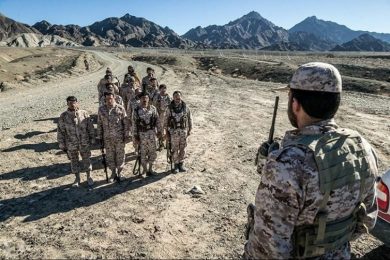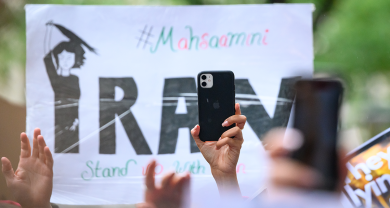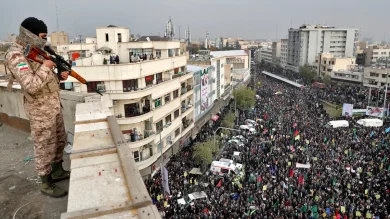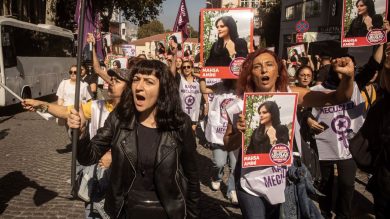In Iran, the hijab is more than just a piece of clothing—it is a tool of state control, a symbol of enforced ideology, and, more recently, a powerful emblem of resistance. For decades, Iranian women have challenged compulsory veiling not just for personal freedom, but to confront an entire system of patriarchal governance represented and enforced by the Islamic Republic and its militant arm, the Islamic Revolutionary Guard Corps (IRGC).
In the wake of Mahsa Amini’s death in September 2022 while in the custody of Iran’s so-called morality police, the hijab became a flashpoint. Women across the country began removing their headscarves in public, burning them in the streets, and cutting their hair—acts that were once punishable offenses, now transformed into acts of national defiance.
This report explores how the hijab has evolved from a state-mandated symbol into a global icon of resistance, and how Iranian women’s protests have leveraged this transformation to challenge not only gender-based oppression, but the entire legitimacy of the authoritarian regime.
1. Historical Context: The Hijab and State Power in Iran
The Pre-Revolution Era
Before the 1979 Islamic Revolution, Iranian women had the legal freedom to choose whether to wear the hijab. Urban centers were diverse in dress, with some women veiled and others in Western attire. However, under the Pahlavi monarchy, forced unveiling also took place—demonstrating that state control over women’s dress has a long and complex history in Iran.
Post-1979 Revolution and Mandated Veiling
After the revolution, Ayatollah Khomeini and the Islamic Republic moved swiftly to enforce compulsory hijab laws. By 1983, it became a criminal offense for women to appear in public without a proper Islamic head covering. The IRGC and Basij militias were given broad powers to enforce compliance, often violently.
Wearing the hijab was no longer a personal or spiritual choice—it became a political requirement, a uniform of submission, and a litmus test of ideological loyalty to the Islamic Republic.
2. The Hijab as a Symbol of Rebellion
From Private Disobedience to Public Protest
Over time, Iranian women began subtly resisting the hijab mandate—pushing their scarves back, showing more hair, or wearing bold colors. These micro-resistances escalated dramatically in 2017 with the “Girls of Revolution Street” campaign, where women publicly removed their headscarves on street corners in protest.
Mahsa Amini and the 2022 Uprising
The death of 22-year-old Mahsa Amini, arrested by the morality police for “improper hijab,” sparked nationwide protests. Her image became iconic, and her name synonymous with defiance. Women burned their hijabs, cut their hair in mourning, and chanted “Women, Life, Freedom”—a slogan that would echo across the globe.
In these protests, the hijab ceased to be merely a garment. It became a metaphor for the regime’s oppression, and its removal a revolutionary act.
3. The Role of the IRGC in Enforcing Hijab Laws
The Islamic Revolutionary Guard Corps (IRGC) plays a central role in enforcing morality policies. Though the morality police operate under the Ministry of Interior, the IRGC and affiliated militias such as the Basij function as enforcers of ideological conformity.
Women who remove their hijab face:
• Arrest and imprisonment
• Torture and solitary confinement
• Public shaming and forced confessions
• Surveillance and harassment online and offline
Digital surveillance, aided by facial recognition and AI, is increasingly used by the IRGC to identify and punish women appearing in public without a hijab.
4. Hijab as a Global Symbol of Resistance
International Solidarity
The image of Iranian women burning their hijabs resonated globally, inspiring:
• Protests in Western capitals
• Public hijab removals by activists in solidarity
• A global conversation on women’s bodily autonomy
Celebrities, politicians, and human rights organizations amplified the message, making the hijab protests a global feminist cause.
Reclaiming the Narrative
By turning the hijab—a tool of oppression—into a tool of resistance, Iranian women reclaimed their narrative. No longer passive victims, they became leaders of a movement for national liberation.
This is not just about clothing; it’s about liberating choice, identity, and agency from state control.
5. The Intersection of Gender, Politics, and Protest
Not Just a Women’s Issue
While the hijab mandate directly affects women, the protest against it has united:
• Men
• Ethnic minorities (Kurds, Baluchis)
• Students
• Workers
• Artists and intellectuals
This unification shows the interconnectedness of gender oppression and authoritarianism, and how resisting one is resisting all.
The Generational Shift
Generation Z, raised in a digitally connected world, is leading the way. They are fearless, creative, and politically conscious. For them, wearing the hijab is not just about religion—it’s a symbol of everything they reject: authoritarianism, hypocrisy, and state violence.
6. The Price of Defiance
Imprisonment and Torture
Dozens of women have been arrested for protesting hijab laws. Some notable cases:
• Narges Mohammadi: Repeatedly jailed for advocating against compulsory hijab.
• Sepideh Rashno: Arrested for confronting a veiled woman and forced into a televised confession.
• Nasrin Sotoudeh: Sentenced to 38 years and 148 lashes for defending women’s right to choose.
Martyrdom and State Violence
Many young women have been killed by security forces during protests. The regime often withholds bodies, pressures families, and controls media coverage to suppress outrage.
Their names—Nika Shakarami, Hadis Najafi, Sarina Esmailzadeh—live on as martyrs of the movement.
7. Government Response and IRGC Strategy
Doubling Down on Enforcement
Instead of reform, the regime has intensified repression, including:
• Deploying more morality patrols
• Arresting journalists who cover hijab protests
• Shutting down businesses that serve unveiled women
• Threatening harsher digital censorship
The IRGC continues to treat hijab resistance as a national security threat, tying it to foreign plots and “soft war” narratives.
8. The Road Ahead: Can Hijab Resistance Lead to Systemic Change?
Hijab as the First Domino
The protest against the hijab is not isolated—it’s the first domino in a larger movement. If the regime loses control over this symbolic issue, it risks losing control over:
• Freedom of speech
• Political expression
• Minority rights
• Theocratic legitimacy
A Feminist Revolution in the Making
This movement is not just about personal liberty, it’s about a feminist revolution—led by women, joined by men, and focused on overthrowing the architecture of oppression.
9. Global Responsibility: How the World Can Help
To support Iranian women and their movement:
• Amplify their stories
• Sanction IRGC officials involved in gender-based repression
• Support digital security tools
• Pressure international bodies to address gender apartheid in Iran
The international feminist community, in particular, has a role to play in making sure Iranian women are not alone.
Conclusion: Beyond the Hijab Lies Freedom
The hijab, once a tool of forced obedience, has become a flag of rebellion. Iranian women are not just rejecting a dress code; they are rejecting a regime. Their courage has transformed a symbol of silence into a global cry for liberation.
Join Our Newsletter!
Stay informed with the latest updates, news, and ways to take action in the fight for justice and global security. Sign up now to get updates delivered straight to your inbox!





